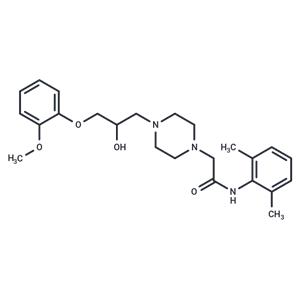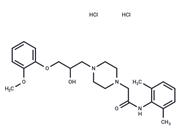| Name | Ranolazine |
| Description | Ranolazine (RS 43285-003) is a calcium uptake inhibitor via the sodium/calcium channel, used to treat chronic angina. It affects the sodium-dependent calcium channels during myocardial ischemia in rabbits by altering the intracellular sodium level. |
| Kinase Assay | In vitro kinase assay for CDK1 and Aurora kinases:CDK1 kinase activity is tested by the CDK1/cyclin B complex purified from baculovirus to phosphorylate a biotinylated peptide substrate containing the consensus phosphorylation site for histone H1, which is phosphorylated in vivo by CDK1. Inhibition of CDK1 activity is measured by observing a decreased amount of 33P-γ-ATP incorporation into the immobilized substrate in streptavidin-coated 96-well scintillating microplates. CDK1 enzyme is diluted in 50 mM Tris-HCl (pH 8), 10 mM MgCl2, 0.1 mM Na3VO4, 1 mM DTT, 1% DMSO, 0.25 μM peptide, 0.1 μCi per well 33P-γ-ATP, and 5 μM ATP in the presence or absence of various concentrations of JNJ-7706621 and incubated at 30 °C for 1 hour. The reaction is terminated by washing with PBS containing 100 mM EDTA and plates are counted in a scintillation counter. IC50 is determined by Linear regression analysis of the percent inhibition by JNJ-7706621.The Aurora kinase activity is measured with 10 μM ATP and a peptide containing a dual repeat of the kemptide phosphorylation motif. |
| In vitro | In the absence and presence of IK-blocking drugs, when late INa is increased, Ranolazine inhibits the late component of INa and attenuates prolongation of action potential duration. Ranolazine (10 mM) reduces by 89% of the 13.6-fold increase in variability of APD caused by 10 nM ATX-II. Ranolazine is found to bind more tightly to the inactivated state than the resting state of the sodium channel underlying I(NaL), with apparent dissociation constants K(dr)=7.47 mM and K(di)=1.71 mM, respectively. Ranolazine(5 mM and 10 mM) reversibly shortens the duration of TCs and abolishes the after contraction. |
| In vivo | In dog left ventricular myocytes, Ranolazine significantly and reversibly stimulate the action potential duration (APD) of shortened myocytes at 0.5 or 0.25 Hz in a concentration-dependent manner. In rat hearts, Ranolazine (10 mM) significantly increased 1.5-fold to 3-fold under glucose oxidation conditions. Ranolazine (10 mM) also increased glucose oxidation (high calcium, low FA; 15 ml/min) in Langendorff hearts in normoxic rats. Ranolazine significantly improves the function of the reperfused ischemic working heart, which is associated with a significant increase in glucose oxidation function. |
| Storage | Powder: -20°C for 3 years | In solvent: -80°C for 1 year | Shipping with blue ice. |
| Solubility Information | H2O : < 1 mg/mL (insoluble or slightly soluble)
Ethanol : 16 mg/mL (37.4 mM)
DMSO : 60 mg/mL (140.34 mM)
|
| Keywords | CVT303 | Na+ channels | Ca2+ channels | inhibit | CVT-303 | Sodium Channel | Inhibitor | Calcium Channel | Ranolazine | Na channels | Ca channels |
| Inhibitors Related | Nisoldipine | Phenytoin sodium | Diltiazem hydrochloride | L-Ascorbic acid | Lidocaine | Lanthanum(III) chloride heptahydrate | Lidocaine hydrochloride | L-Aspartic aicd sodium | Ethyl cinnamate | 1-Octanol |
| Related Compound Libraries | Bioactive Compound Library | Membrane Protein-targeted Compound Library | EMA Approved Drug Library | Inhibitor Library | Neuroprotective Compound Library | Anti-Cancer Approved Drug Library | FDA-Approved Drug Library | Bioactive Compounds Library Max | Ion Channel Targeted Library | Anti-Cancer Drug Library |

 United States
United States



